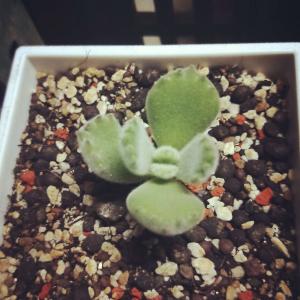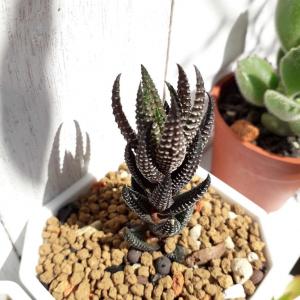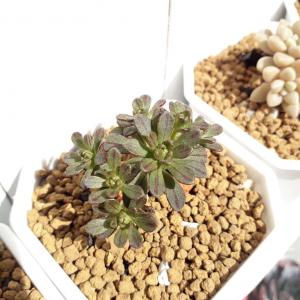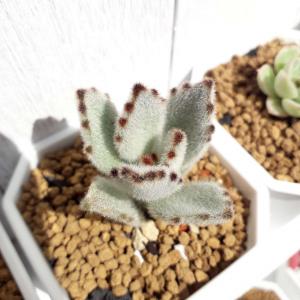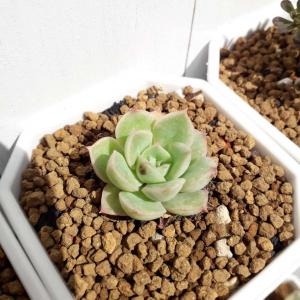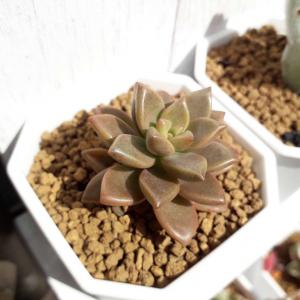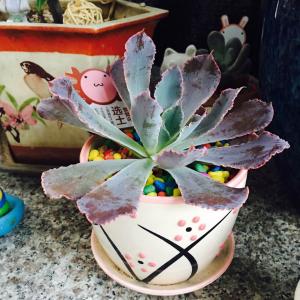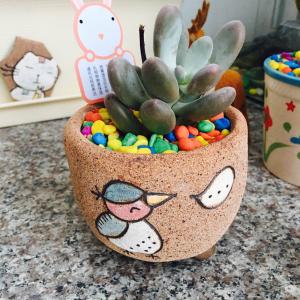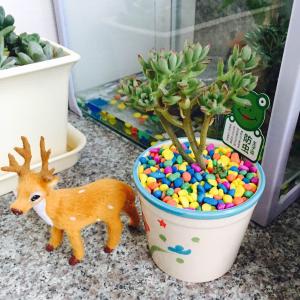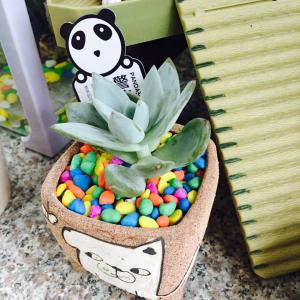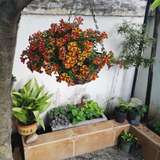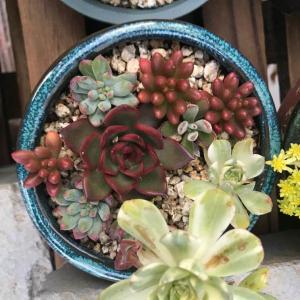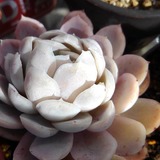文章
我说肉肉你说萌!
2018年04月29日
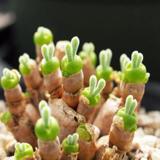
然后可能出现一个问题,为什么多肉才种两三天,多肉就化水、黑掉、异色。
因为今年的春天有点烦,以厦门为例,才4月,已经连续两天最高气温30℃了(去年的同期是20℃,上30℃是5月以后的事了),缓苗期直接露养,光照太强,很容易病菌侵入感染,再考虑到一部分人种植前可能也没修根晾根,出问题也就是概率事件。多肉是喜光照植物没错,但是缓苗期,只要不徒长,只要不褪色,真的是光照越少越好,一旦温度上了30℃,通风明亮无直射光处是多肉缓苗安身立命之本。
除了刚买回来的多肉种下要缓苗之外,原本在室内种植的,这段时间搬出来,也要注意缓苗,不能一下子就全日照,当下植株比较娇嫩,全日照,轻则晒伤,种则晒黑、化水、异色。
花友淡淡的烟味,原本种在室内,搬出去晒了两天的多肉


还有,盆土太潮湿,光照太强,温度太高,也会容易引起一些景天属的多肉掉叶子化水,尤其是园土、沙土这类保水性太强又不透气的,应注意控水通风。
刚买回来这种带土而且是园土的,有一个毛病,土很容易湿很久,高温下容易出事。

总的来说,最近温度一下子上30℃的地区,应多留意下自家的多肉,一些长势不佳的,如叶片长期干瘪,叶片消耗过快,有掉叶化水迹象的,可以适当遮阴,做下度夏准备了。
因为今年的春天有点烦,以厦门为例,才4月,已经连续两天最高气温30℃了(去年的同期是20℃,上30℃是5月以后的事了),缓苗期直接露养,光照太强,很容易病菌侵入感染,再考虑到一部分人种植前可能也没修根晾根,出问题也就是概率事件。多肉是喜光照植物没错,但是缓苗期,只要不徒长,只要不褪色,真的是光照越少越好,一旦温度上了30℃,通风明亮无直射光处是多肉缓苗安身立命之本。
除了刚买回来的多肉种下要缓苗之外,原本在室内种植的,这段时间搬出来,也要注意缓苗,不能一下子就全日照,当下植株比较娇嫩,全日照,轻则晒伤,种则晒黑、化水、异色。
花友淡淡的烟味,原本种在室内,搬出去晒了两天的多肉


还有,盆土太潮湿,光照太强,温度太高,也会容易引起一些景天属的多肉掉叶子化水,尤其是园土、沙土这类保水性太强又不透气的,应注意控水通风。
刚买回来这种带土而且是园土的,有一个毛病,土很容易湿很久,高温下容易出事。

总的来说,最近温度一下子上30℃的地区,应多留意下自家的多肉,一些长势不佳的,如叶片长期干瘪,叶片消耗过快,有掉叶化水迹象的,可以适当遮阴,做下度夏准备了。
3
3
求助
珍惜388759
2018年04月27日

搞不懂这颗紫雾泡泡的花苞了,图二正常,有4个花苞,图一现蕾最早,可现在就只看到一个花苞,其他该长花苞的地方长了叶子,这是什么情况?
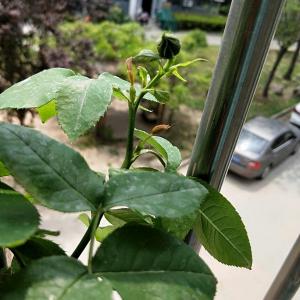



0
0
sunnyzou:盲枝,可以回缩,剪掉一些。
文章
Miss Chen
2018年04月25日

Description: This is a herbaceous perennial plant with the leaves and flowers emerging directly from the rhizomes, and forming a basal rosette. A typical mature plant may be 6" across and 4" high, with the flowers slightly higher than the leaves. The leaves are individually up to 3" long and 3" across (excluding the long petioles), and vary in color from yellowish green to dark green, depending on growing conditions. They are oval-ovate to orbicular-cordate in shape, and crenate or serrate along the margins. Different populations of plants can vary in the hairiness of their leaves – from nearly glabrous to conspicuously hairy or pubescent. The flowers are about ¾" across, and consist of 5 rounded petals. There are 2 upper petals, 2 lateral petals with white hairs (or beards) near the throat of the flower, and a lower petal that functions as a landing pad for visiting insects. The flowers of this form of Viola sororia are medium to dark violet. The inner throat of each flower is more or less white, from which slightly darker veins radiate outward along the petals (particularly the lower one). There is no noticeable floral scent. The blooming period occurs from mid- to late spring, and lasts about 1-1½ months. During the summer, cleistogamous flowers without petals produce seeds, which are flung outward by mechanical ejection from the three-parted seed capsules. The root system consists of thick, horizontally branched rhizomes; there is a tendency to form vegetative colonies.
Cultivation: The preference is partial sun or light shade, and moist to average conditions, although full sun is tolerated if there is sufficient moisture. The soil should be a rich silty loam or clay loam with above average amounts of organic matter. The leaves have a tendency to turn yellowish green when exposed to full sun under dry conditions – this reaction is normal, and is not necessarily a sign of poor health. This plant is very easy to grow, and it will spread under favorable conditions. This wildflower will adapt to lawns, especially if they are not mowed too often during the spring or cut too low.
Habitat & Range: The native Common Blue Violet occurs in every county in Illinois and it is very common (see Distribution Map). Natural habitats include moist to mesic black soil prairies, open woodlands, woodland edges, savannas, and wooded slopes along rivers or lakes. In developed areas, it can be found in lawns, city parks, moist waste areas, and along hedges or buildings. Sometimes the Common Blue Violet is grown in flower gardens.

Faunal Associations: The flowers are not often visited by insects (hence the need for cleistogamous flowers), but sometimes they attract bees (e.g., Mason, Halictid), skippers, Syrphid flies, and other insects. The Syrphid flies, however, feed only on stray pollen and are non-pollinating. The caterpillars of many Fritillary butterflies feed on the foliage, including Speyeria diane (Diana), Euptoieta claudia (Variegated Fritillary), Speyeria aphrodite (Aphrodite Fritillary), Boloria bellona (Meadow Fritillary), and Boloria selene myrina (Silver-Border Fritillary). The seeds have soft appendages that attract ants, which are in part distributed by them. Various upland gamebirds and small mammals occasionally eat the seeds, including the Wild Turkey, Bobwhite, Mourning Dove, and White-Footed Mouse. Wild Turkeys also eat the leaves and fleshy roots of Viola spp. (Violets). Although it is not a preferred food source, mammalian herbivores occasionally eat the foliage of violets, including the White-Tailed Deer, Cottontail Rabbit, and livestock.
Photographic Location: The photographs were taken at the webmaster's wildflower garden in Urbana, Illinois, Crystal Lake Park of the same city, and at the edge of an agricultural field outside of the same city in Champaign County, Illinois.

Comments: The flowers and young leaves of violets are edible, and can be added to salads in small amounts. The taste is bland. This is the most common Viola sp. (Violet) in Illinois. There are several forms of Viola sororia with differently colored flowers; these often grow in close proximity to each other in a given area. The typical form that is described here, f. sororia, has medium to dark violet flowers and rather well-rounded leaves. Some authorities (e.g., Mohlenbrock) consider these different color forms to be separate species, but this does not seem appropriate to me. Some authorities also consider pubescent and non-pubescent specimens of Common Blue Violet to be separate species, but they tend to intergrade in the field, possibly in response to levels of sunlight in a given habitat. However, if this taxonomic distinction is accepted, then non-pubescent specimens can be referred to as Viola pratincola (Common Blue Violet), while pubescent specimens can be referred to as Viola sororia (Woolly Blue Violet). Because the plants in the above photographs are non-pubescent, they would be considered specimens of Viola pratincola according to this taxonomy.
Cultivation: The preference is partial sun or light shade, and moist to average conditions, although full sun is tolerated if there is sufficient moisture. The soil should be a rich silty loam or clay loam with above average amounts of organic matter. The leaves have a tendency to turn yellowish green when exposed to full sun under dry conditions – this reaction is normal, and is not necessarily a sign of poor health. This plant is very easy to grow, and it will spread under favorable conditions. This wildflower will adapt to lawns, especially if they are not mowed too often during the spring or cut too low.
Habitat & Range: The native Common Blue Violet occurs in every county in Illinois and it is very common (see Distribution Map). Natural habitats include moist to mesic black soil prairies, open woodlands, woodland edges, savannas, and wooded slopes along rivers or lakes. In developed areas, it can be found in lawns, city parks, moist waste areas, and along hedges or buildings. Sometimes the Common Blue Violet is grown in flower gardens.

Faunal Associations: The flowers are not often visited by insects (hence the need for cleistogamous flowers), but sometimes they attract bees (e.g., Mason, Halictid), skippers, Syrphid flies, and other insects. The Syrphid flies, however, feed only on stray pollen and are non-pollinating. The caterpillars of many Fritillary butterflies feed on the foliage, including Speyeria diane (Diana), Euptoieta claudia (Variegated Fritillary), Speyeria aphrodite (Aphrodite Fritillary), Boloria bellona (Meadow Fritillary), and Boloria selene myrina (Silver-Border Fritillary). The seeds have soft appendages that attract ants, which are in part distributed by them. Various upland gamebirds and small mammals occasionally eat the seeds, including the Wild Turkey, Bobwhite, Mourning Dove, and White-Footed Mouse. Wild Turkeys also eat the leaves and fleshy roots of Viola spp. (Violets). Although it is not a preferred food source, mammalian herbivores occasionally eat the foliage of violets, including the White-Tailed Deer, Cottontail Rabbit, and livestock.
Photographic Location: The photographs were taken at the webmaster's wildflower garden in Urbana, Illinois, Crystal Lake Park of the same city, and at the edge of an agricultural field outside of the same city in Champaign County, Illinois.

Comments: The flowers and young leaves of violets are edible, and can be added to salads in small amounts. The taste is bland. This is the most common Viola sp. (Violet) in Illinois. There are several forms of Viola sororia with differently colored flowers; these often grow in close proximity to each other in a given area. The typical form that is described here, f. sororia, has medium to dark violet flowers and rather well-rounded leaves. Some authorities (e.g., Mohlenbrock) consider these different color forms to be separate species, but this does not seem appropriate to me. Some authorities also consider pubescent and non-pubescent specimens of Common Blue Violet to be separate species, but they tend to intergrade in the field, possibly in response to levels of sunlight in a given habitat. However, if this taxonomic distinction is accepted, then non-pubescent specimens can be referred to as Viola pratincola (Common Blue Violet), while pubescent specimens can be referred to as Viola sororia (Woolly Blue Violet). Because the plants in the above photographs are non-pubescent, they would be considered specimens of Viola pratincola according to this taxonomy.
0
0
文章
Miss Chen
2018年04月25日

Description: This is a herbaceous perennial plant with the leaves and flowers emerging directly from the rhizomes, and forming a basal rosette. A typical mature plant may be 6" across and 4" high, with the flowers slightly higher than the leaves. The leaves are individually up to 3" long and 3" across (excluding the long petioles), and vary in color from medium to dark green, depending on growing conditions. They are oval-ovate to orbicular-cordate, and crenate or serrate along the margins. The foliage is glabrous to slightly pubescent. The flowers are about ¾" across, and consist of 5 rounded petals; there are 2 upper petals, 2 lateral petals with white hairs (or beards) near the throat of the flower, and a lower petal that functions as a landing pad for visiting insects. Behind the petals, there are 5 sepals that are green and lanceolate. The petals of this form of Viola sororia are a mottled combination of blue-violet with white; from a distance, they appear pale to medium blue-violet. From the throat of the flower, there are dark blue-violet lines radiating outward (particularly on the lower petal). There is no noticeable floral scent. The blooming period occurs from mid- to late spring and lasts about 1-1½ months. During the summer, cleistogamous flowers without petals produce seeds, which are flung outward by mechanical ejection from the three-parted seed capsules. The root system consists of thick, horizontally branched rhizomes; there is a tendency to form vegetative colonies.
Cultivation: The preference is partial sun or light shade, and moist to mesic conditions, although full sun is tolerated if there is sufficient moisture. The soil should be a rich silty loam or clay loam with above average amounts of organic matter. This plant is easy to grow, and it will spread under favorable conditions.
Habitat & Range: The Confederate Violet is occasional to locally common in Illinois; a Distribution Map is unavailable because the Confederate Violet is (or was) considered a mere color form of Viola sororia. Natural habitats include meadows, open woodlands, woodland borders, savannas, and wooded slopes along rivers or lakes. In more developed areas, it is sometimes found in city parks, lawns, and along hedges or buildings.

Faunal Associations: The flowers have few visitors (hence the need for cleistogamous flowers), but sometimes they attract bees and other insects. The species Andrena viola (Violet Andrenid Bee) is an oligolectic visitor of Viola spp. (Violets). The caterpillars of many Fritillary butterflies (Speyeria spp., Boloria spp., & Euptoieta claudia) feed on the foliage of Violets. Various upland gamebirds and small mammals occasionally eat the seeds, including the Wild Turkey, Bobwhite, Mourning Dove, and White-Footed Mouse. Wild Turkeys also eat the leaves and fleshy roots of violets. Although it is not a preferred food source, mammalian herbivores occasionally eat the foliage.
Photographic Location: The photographs was taken at Crystal Lake Park and Judge Webber Park in Urbana, Illinois.

Comments: The Confederate Violet is the mottled form, f. priceana, of Viola sororia. The common name of this violet refers to the resemblance of the color of its flowers to the color of Confederate uniforms during the Civil War (pale greyish blue). The typical form of this species, Viola sororia sororia (Common Blue Violet), which is more common, has flowers with a more homogenous shade of medium to dark violet. Some authorities (e.g., Mohlenbrock) classify the Confederate Violet as a distinct species, Viola priceana; in this taxonomic reclassification, it appears that no distinction has been made between the Confederate Violet and Viola sororia albiflora (White Wood Violet). I disagree with this taxonomic revision as the Confederate Violet appears to freely hybridize with both the Common Blue Violet and White Wood Violet, and they often occur together in the same habitats. This viewpoint is consistent with the taxonomic classification of the American Violet Society.
Cultivation: The preference is partial sun or light shade, and moist to mesic conditions, although full sun is tolerated if there is sufficient moisture. The soil should be a rich silty loam or clay loam with above average amounts of organic matter. This plant is easy to grow, and it will spread under favorable conditions.
Habitat & Range: The Confederate Violet is occasional to locally common in Illinois; a Distribution Map is unavailable because the Confederate Violet is (or was) considered a mere color form of Viola sororia. Natural habitats include meadows, open woodlands, woodland borders, savannas, and wooded slopes along rivers or lakes. In more developed areas, it is sometimes found in city parks, lawns, and along hedges or buildings.

Faunal Associations: The flowers have few visitors (hence the need for cleistogamous flowers), but sometimes they attract bees and other insects. The species Andrena viola (Violet Andrenid Bee) is an oligolectic visitor of Viola spp. (Violets). The caterpillars of many Fritillary butterflies (Speyeria spp., Boloria spp., & Euptoieta claudia) feed on the foliage of Violets. Various upland gamebirds and small mammals occasionally eat the seeds, including the Wild Turkey, Bobwhite, Mourning Dove, and White-Footed Mouse. Wild Turkeys also eat the leaves and fleshy roots of violets. Although it is not a preferred food source, mammalian herbivores occasionally eat the foliage.
Photographic Location: The photographs was taken at Crystal Lake Park and Judge Webber Park in Urbana, Illinois.

Comments: The Confederate Violet is the mottled form, f. priceana, of Viola sororia. The common name of this violet refers to the resemblance of the color of its flowers to the color of Confederate uniforms during the Civil War (pale greyish blue). The typical form of this species, Viola sororia sororia (Common Blue Violet), which is more common, has flowers with a more homogenous shade of medium to dark violet. Some authorities (e.g., Mohlenbrock) classify the Confederate Violet as a distinct species, Viola priceana; in this taxonomic reclassification, it appears that no distinction has been made between the Confederate Violet and Viola sororia albiflora (White Wood Violet). I disagree with this taxonomic revision as the Confederate Violet appears to freely hybridize with both the Common Blue Violet and White Wood Violet, and they often occur together in the same habitats. This viewpoint is consistent with the taxonomic classification of the American Violet Society.
0
0
文章
Miss Chen
2018年04月25日

Description: This is a herbaceous perennial plant with the leaves and flowers emerging directly from the rhizomes, and forming a basal rosette. A typical mature plant may be 6" across and 4" high, with the flowers slightly higher than the leaves. The leaves are individually up to 3" long and 3" across (excluding the long petioles), and vary in color from pale green to dark green, depending on growing conditions. They are oval-ovate to orbicular-cordate, and crenate or serrate along the margins. The foliage is glabrous to slightly pubescent. The flowers are about ¾" across, and consist of 5 rounded petals. There are 2 upper petals, 2 lateral petals with white hairs (or beards) near the throat of the flower, and a lower petal that functions as aClose-up of Flower landing pad for visiting insects. The flowers of this form of Viola sororia are white to mostly white, except for violet lines radiating from the throat of the flower (particularly the lower petal). There is no noticeable floral scent. The blooming period occurs from mid- to late spring and lasts about 1-1½ months. During the summer, cleistogamous flowers without petals produce seeds, which are flung outward by mechanical ejection from the three-parted seed capsules. The root system consists of thick, horizontally branched rhizomes; there is a tendency to form vegetative colonies.
Cultivation: The preference is partial sun or light shade, and moist to mesic conditions, although full sun is tolerated if there is sufficient moisture. The soil should be a rich silty loam or clay loam with above average amounts of organic matter. This plant is easy to grow, and it will spread under favorable conditions.
Habitat & Range: The native White Wood Violet is occasional to locally common in Illinois; because it is (or was) considered a mere color form of Viola sororia, a Distribution Map is currently unavailable. Natural habitats include open woodlands, woodland borders, savannas, and wooded slopes along rivers or lakes. In more developed areas, it is sometimes found in city parks, lawns, and along hedges or buildings. It is often found in close proximity to Viola sororia sororia (Common Blue Violet).
Faunal Associations: The flowers have few visitors (hence the need for cleistogamous flowers), but sometimes they attract bees and other insects. The species Andrena viola (Violet Andrenid Bee) is an oligolectic visitor of Viola spp. (Violets). The caterpillars of many Fritillary butterflies feed on the foliage of violets, including Speyeria diane (Diana), Euptoieta claudia (Variegated Fritillary), Speyeria aphrodite (Aphrodite Fritillary), Boloria bellona (Meadow Fritillary), and Boloria selene myrina (Silver-Border Fritillary). Some seeds have soft appendages that attract ants, which help to distribute them. Various upland gamebirds and small mammals occasionally eat the seeds, including the Wild Turkey, Bobwhite, Mourning Dove, and White-Footed Mouse. Wild Turkeys also eat the leaves and fleshy roots of violets. Although it is not a preferred food source, mammalian herbivores occasionally eat the foliage, including the White-Tailed Deer, Cottontail Rabbit, and livestock.

Photographic Location: The photographs were taken of plants growing along the edge of a yard in Urbana, Illinois.
Comments: The White Wood Violet is the white form, f. albiflora, of Viola sororia. The typical form of this species, Viola sororia sororia (Common Blue Violet), which is more common, has medium to dark violet flowers. Generally, the White Wood Violet doesn't appear to spread as aggressively as the typical form of this species; it is equally attractive and its light-colored flowers are more conspicuous in shady areas. Some authorities (e.g., Mohlenbrock) combine the White Wood Violet with Viola sororia priceana (Confederate Violet) and regard the two of them together as a distinct species, Viola priceana. However, I disagree with this taxonomic revision and prefer to regard them as distinct color forms of Viola sororia at the present time. This corresponds to the taxonomic classification of the American Violet Society.
Cultivation: The preference is partial sun or light shade, and moist to mesic conditions, although full sun is tolerated if there is sufficient moisture. The soil should be a rich silty loam or clay loam with above average amounts of organic matter. This plant is easy to grow, and it will spread under favorable conditions.
Habitat & Range: The native White Wood Violet is occasional to locally common in Illinois; because it is (or was) considered a mere color form of Viola sororia, a Distribution Map is currently unavailable. Natural habitats include open woodlands, woodland borders, savannas, and wooded slopes along rivers or lakes. In more developed areas, it is sometimes found in city parks, lawns, and along hedges or buildings. It is often found in close proximity to Viola sororia sororia (Common Blue Violet).
Faunal Associations: The flowers have few visitors (hence the need for cleistogamous flowers), but sometimes they attract bees and other insects. The species Andrena viola (Violet Andrenid Bee) is an oligolectic visitor of Viola spp. (Violets). The caterpillars of many Fritillary butterflies feed on the foliage of violets, including Speyeria diane (Diana), Euptoieta claudia (Variegated Fritillary), Speyeria aphrodite (Aphrodite Fritillary), Boloria bellona (Meadow Fritillary), and Boloria selene myrina (Silver-Border Fritillary). Some seeds have soft appendages that attract ants, which help to distribute them. Various upland gamebirds and small mammals occasionally eat the seeds, including the Wild Turkey, Bobwhite, Mourning Dove, and White-Footed Mouse. Wild Turkeys also eat the leaves and fleshy roots of violets. Although it is not a preferred food source, mammalian herbivores occasionally eat the foliage, including the White-Tailed Deer, Cottontail Rabbit, and livestock.

Photographic Location: The photographs were taken of plants growing along the edge of a yard in Urbana, Illinois.
Comments: The White Wood Violet is the white form, f. albiflora, of Viola sororia. The typical form of this species, Viola sororia sororia (Common Blue Violet), which is more common, has medium to dark violet flowers. Generally, the White Wood Violet doesn't appear to spread as aggressively as the typical form of this species; it is equally attractive and its light-colored flowers are more conspicuous in shady areas. Some authorities (e.g., Mohlenbrock) combine the White Wood Violet with Viola sororia priceana (Confederate Violet) and regard the two of them together as a distinct species, Viola priceana. However, I disagree with this taxonomic revision and prefer to regard them as distinct color forms of Viola sororia at the present time. This corresponds to the taxonomic classification of the American Violet Society.
1
0
文章
权问薇
2018年04月24日


1、土壤
栀子花喜欢酸性环境,所以土壤一定要呈酸性,忌碱性。栽培的壤土可以选用腐叶土、菜园土、腐熟土、河沙以4:4:1:1的比例混合的土壤,但一定要保证其透气性和渗水性良好。

2、温度
它最佳的生长发育温度是在20至25℃之间,能忍受-3℃的低温,但不可久置,不然会造成冻伤。当温度高于15℃时要及时开窗通风,舒缓燥热,以利于其之后的生长、开花。
3、光照
它的生长环境一般光照非常充足,特别是春秋两季,每天都要保证它能接受至少8小时的日照,否则对其以后的越冬和生长都极为不利。但在阳光炽热的夏季,要避免强光曝晒,最好将其放在散光的地方养护,入冬之后再转移到阳光直射处养殖。

4、施肥
它并不喜肥,但也需要定期补充肥料,在施加肥料的前一天要停止浇水,大约十天一次施加腐熟的肥料即可,施过肥后再浇一次透水,九月份中旬基本就停止施肥了。
5、浇水
春秋比较干燥,做到每三天浇一次水即可,而夏天要在温度降下来后浇水,大约是下午两点。冬季要控制浇水,等盆土干燥时再浇水。

1
3
文章
Miss Chen
2018年04月24日

Description: This wildflower is an annual, biennial, or short-lived perennial about 3-6' tall; it branches occasionally in the upper half. The central stem is light green, stout, 4-angled, and densely covered with long spreading hairs. Along its length are pairs of opposite leaves up to 6" long and 2¼" across; they are lanceolate to ovate and coarsely serrated along their margins. The upper surface of each leaf is medium to dark green, shiny, hairless to slightly hairy, and wrinkled along the veins; its lower surface is light green and more hairy. The petioles of the leaves are up to 2" long. The central stem terminates in a panicle of floral spikes up to 2' long and half as much across; the upper side stems also terminate in such panicles, although they are smaller in size. Each panicle has narrow ascending branches (up to 6" long) and an airy appearance; sessile small flowers are sparsely distributed along each of these branches. Each flower is 1/8" (3 mm.) across, consisting of a white corolla with 5 rounded lobes and a tubular green calyx with 5 lanceolate teeth. The blooming period occurs from mid-summer to early fall and lasts about 1½ months. Only a few flowers bloom at the same time. Each flower is replaced by 4 nutlets that are oblongoid and flattened. This wildflower reproduces by reseeding itself.
Cultivation: The preference is partial sun, moist to mesic conditions, and a fertile loam, clay-loam, or silt-loam. This wildflower can be started from seed, but it is short-lived.
Range & Habitat: The native White Vervain occurs in every county of Illinois and it is quite common (see Distribution Map). Habitats include open disturbed woodlands, woodland borders, thickets, powerline clearances in wooded areas, semi-shaded areas along paths, damp meadows along streams, gravelly seeps, and abandoned fields. White Vervain is usually found in habitats with a history of disturbance. It is somewhat weedy, but rarely forms colonies, existing primarily as scattered individual plants.

Faunal Associations: The nectar and pollen of the flowers attract long-tongued bees (honeybees, bumblebees, Little Carpenter bees, Cuckoo bees, Digger bees, & Large Leaf-Cutting bees), short-tongued bees (Halictid bees, & Dagger bees, including Calliopsis verbenae), various flies (Syrphid flies, Bee flies, Thick-Headed flies, & Tachinid flies), small butterflies, and wasps. These insects cross-pollinate the flowers. Insects that feed on the foliage and other parts of White Vervain and other Verbena spp. (Vervains) include the larvae of Crambodes talidiformis (Verbena Moth), Longitarsus suspectus (Flea Beetle sp.), larvae of Clinodiplosis verbenae (Vervain Leaf Midge), Macrosiphum verbenae (Verbena Aphid), and Melanoplus bivittatus (Two-striped Grasshopper). The seeds are eaten occasionally by various granivorous songbirds, including the Slate-Colored Junco, Field Sparrow, Song Sparrow, Swamp Sparrow, Tree Sparrow, and White-Crowned Sparrow. In contrast, the bitter coarse foliage is rarely used as a food source by White-Tailed Deer and other mammalian herbivores.
Photographic Location: Along a path in Busey Woods at Urbana, Illinois.
Comments: Considering the large size of this plant, its flowers are remarkably small. The lanky branches of the inflorescence are rather long, however, and they sprawl in different directions. This makes the inflorescence difficult to photograph in its entirety. The scientific name of this plant refers to the resemblance of its leaves to those of Urtica spp. (nettles). White Vervain resembles two of its relatives, Verbena hastata (Blue Vervain) and Verbena officinalis (European Vervain). Blue Vervain has more narrow leaves and its flowers are conspicuously blue, rather than bright white. It is found in sunny wetland habitats more often than White Vervain. European Vervain has small flowers that are white or lavender. It differs from White Vervain primarily by its pinnatifid leaves, which have cleft lobes.
Cultivation: The preference is partial sun, moist to mesic conditions, and a fertile loam, clay-loam, or silt-loam. This wildflower can be started from seed, but it is short-lived.
Range & Habitat: The native White Vervain occurs in every county of Illinois and it is quite common (see Distribution Map). Habitats include open disturbed woodlands, woodland borders, thickets, powerline clearances in wooded areas, semi-shaded areas along paths, damp meadows along streams, gravelly seeps, and abandoned fields. White Vervain is usually found in habitats with a history of disturbance. It is somewhat weedy, but rarely forms colonies, existing primarily as scattered individual plants.

Faunal Associations: The nectar and pollen of the flowers attract long-tongued bees (honeybees, bumblebees, Little Carpenter bees, Cuckoo bees, Digger bees, & Large Leaf-Cutting bees), short-tongued bees (Halictid bees, & Dagger bees, including Calliopsis verbenae), various flies (Syrphid flies, Bee flies, Thick-Headed flies, & Tachinid flies), small butterflies, and wasps. These insects cross-pollinate the flowers. Insects that feed on the foliage and other parts of White Vervain and other Verbena spp. (Vervains) include the larvae of Crambodes talidiformis (Verbena Moth), Longitarsus suspectus (Flea Beetle sp.), larvae of Clinodiplosis verbenae (Vervain Leaf Midge), Macrosiphum verbenae (Verbena Aphid), and Melanoplus bivittatus (Two-striped Grasshopper). The seeds are eaten occasionally by various granivorous songbirds, including the Slate-Colored Junco, Field Sparrow, Song Sparrow, Swamp Sparrow, Tree Sparrow, and White-Crowned Sparrow. In contrast, the bitter coarse foliage is rarely used as a food source by White-Tailed Deer and other mammalian herbivores.
Photographic Location: Along a path in Busey Woods at Urbana, Illinois.
Comments: Considering the large size of this plant, its flowers are remarkably small. The lanky branches of the inflorescence are rather long, however, and they sprawl in different directions. This makes the inflorescence difficult to photograph in its entirety. The scientific name of this plant refers to the resemblance of its leaves to those of Urtica spp. (nettles). White Vervain resembles two of its relatives, Verbena hastata (Blue Vervain) and Verbena officinalis (European Vervain). Blue Vervain has more narrow leaves and its flowers are conspicuously blue, rather than bright white. It is found in sunny wetland habitats more often than White Vervain. European Vervain has small flowers that are white or lavender. It differs from White Vervain primarily by its pinnatifid leaves, which have cleft lobes.
0
0



